The purpose of this website is to provide free sermon manuscripts and sermon videos to pastors and
missionaries throughout the world, especially the Third World, where there are few if any
theological
seminaries or Bible schools.
The purpose of this website is to provide free sermon manuscripts and sermon videos to pastors and missionaries throughout the world, especially the Third World, where there are few if any theological seminaries or Bible schools.
These sermon manuscripts and videos now go out to about 1,500,000 computers in over 221 countries every year at www.sermonsfortheworld.com. Hundreds of others watch the videos on YouTube, but they soon leave YouTube and come to our website. YouTube feeds people to our website. The sermon manuscripts are given in 46 languages to about 120,000 computers each month. The sermon manuscripts are not copyrighted, so preachers can use them without our permission.
Please click here to learn how you can make a monthly donation to help us in this great work of preaching the Gospel to the whole world.
Whenever you write to Dr. Hymers always tell him what country you live in, or he cannot answer you. Dr. Hymers’ e-mail is rlhymersjr@sbcglobal.net.
P. T. BARNUM, THE FEEJEE MERMAID
AND THE MISSING LINK!
(WITH PHOTOGRAPHS)
by Dr. R. L. Hymers, Jr.
A sermon preached at the Baptist Tabernacle of Los Angeles
Lord's Day Morning, April 6, 2003
|
"And they shall turn away their ears from the truth, and shall be turned unto fables" (II Timothy 4:4).
|
The Greek word "muthos" is translated as "fables" in the KJV. It means "myths" or "fiction." This passage of Scripture in II Timothy is prophetic. It tells us in advance that mankind would turn away from the truth in the Bible to fables - myths and fiction. That is exactly what happened toward the end of the nineteenth century and continues to this day.
I want you to go back with me to that period of history, in the nineteenth century, to find out the kind of environment in which the theory of evolution came into prominence. Dr. James W. Cook is assistant professor of History and American Culture at the University of Michigan. He has written a book titled, The Arts of Deception: Playing With Fraud in the Age of Barnum (Harvard University Press, 2001). This book is about P. T. Barnum and the many hoaxes he produced for people willing to pay to see his frauds at his famous
"Museum," which later became part of the
Ringling Brothers, Barnum and Bailey Circus.
The jacket of Dr. Cook's book tells us,
The Arts of Deception explores the playful forms of fraud - from automatons to mermaids [and] magicians…that so fascinated nineteenth century America's new middle class. These [frauds] confused the line between reality and illusion, producing public debates over the shifting boundaries of race, class, value, and truth. Cook's…study takes us into the emerging mass culture where P. T. Barnum's brand of trickery flourished, and into the minds of the curiosity-seekers who devoured the wonders before their eyes (ibid., back jacket).
Dr. Cook's book gives profound insight into nineteenth-century popular culture. But why should you, as a modern young person, be interested in what happened in the late nineteenth century? I'll tell you very simply: because it was at that time that so many of the ideas we have in the modern world were formed. What you take for granted in your college classrooms came forth at that time. Let's think of a few of them.
I. First, the late nineteenth century was a time of apostasy.
I have written of this in my book, Today's Apostasy. But I will give a brief overview here. Charles G. Finney and those who followed him challenged the basic beliefs of
Baptists and Protestants during this period. They taught that Baptist and Protestant theology had been wrong since the Reformation. Basic to the new theology of Finney and his followers was the idea that man is not totally depraved. They taught that man was fully capable at all times of rationally understanding and acting upon the truths of the gospel. This was a reintroduction of Pelagianism, which produced shallow evangelism and began to fill the churches with people who had made superficial "decisions," but had not been truly converted.
Historically America and England had experienced several major awakenings. These periods of revival ended with the Third Great Awakening of 1859. It should be noted that this was the same year that Charles Darwin's first major book, On the Origin of Species by Means of Natural Selection, was published. From 1859 onward, to the present day, there has never been a fourth "great awakening." The churches, from that time to ours, have increasingly been filled with more and more unconverted people.
The great denominations, Methodist, Presbyterian, and Baptist, began sliding toward apostasy during the late nineteenth century, largely, I believe, due to decisionism adding unconverted members to the churches. At the same time, the Germans were developing textual criticism of the Bible, which was beginning to undermine the faith of people in the English-speaking world. The great denominations are almost wholly apostate today as a result.
II. Second, the late nineteenth century was a time of
many scientific inventions.
The steam engine propelled boats and railroads, which became the normal means of long distance travel in this period. The internal combustion engine was invented. The electric light, the phonograph, and movies were invented as the nineteenth century drew to a close. Men were already talking about the possibility of flying, medical knowledge took great leaps forward. The automobile was invented. All of these inventions and discoveries in the realm of science caused the common man to begin looking at the world in new ways. Science fiction became reading material for the average man, with such books as H. G. Wells' The Time Machine, written in 1895, and The Island of Dr. Moreau, in 1896, in which an insane scientist experimented genetically with humans and animals - the sort of thing that we are still talking about today. Jules Verne wrote The Journey to the Center of the Earth and Around the World in 80 Days. People were constantly reading about science and science fiction, in an era when Protestant religion was weakening through decisionism, filling the churches with more and more unconverted people. German textual criticism of the Bible was taking its toll on the churches as well. The late nineteenth century experienced a wave of agnosticism and atheism as a result.
Colonel Robert Ingersoll spoke in favor of atheism to huge crowds, often just
across town from D. L. Moody's meetings. This led to the discarding of the Bible and an embracing of science and pseudo-science as a result. Scientism replaced Christianity in the minds of many leading thinkers, from Edison to Darwin, from H. G. Wells to Sigmund Freud. This trend of replacing God with "scientism" continues to this day. The progress in science, and in many other areas, made people very optimistic. Evolution had a great appeal because it seemed to be true that things were getting better and better - that man and society were improving and progressing.
III. Third, the late nineteenth century was a time of colonizing.
As I will bring out in the sermon tonight, the English colonized about one third of the world during the Victorian period of the nineteenth century. This brought many things in far away places to the cities of England, and America. Writers like Rudyard Kipling brought stories from India to every English-speaking child - and adult. People were reading The Jungle Book, and other stories about India and the Orient. Dr. David Livingstone penetrated what was called "Darkest Africa," and mapped large sections of it for explorers who would follow. Even while apostasy was permeating the churches, missionary work, paradoxically, was penetrating regions throughout the world that had never before heard the Protestant message of the gospel.
This world-wide penetration of the English-speaking people throughout the world, through both imperialistic colonization and missionary work, brought many ideas and curiosities back to America and England.
It is not surprising, then, that Edgar Allan Poe wrote, as he did, the first murder mystery, titled Murders in the Rue Morgue, in 1841. The murderer was an ape, which pulled the dead bodies of its victims up into a chimney. Apes had become well known through the exploration of the time - and apes and gorillas were curiosities from the uncivilized world that captured the imaginations of everyone, from adults to school children. Soon they would be reading the Tarzan stories by Edgar Rice Burroughs, and this would pave the way for King Kong, which would hit the movie screens, causing women to faint in the aisles, by 1933.
In 1885 Gilbert and Sullivan staged their newest operetta, "The Mikado." It was set in Japan. The English-speaking world was now confronted with all things Japanese!
In 1890, Sir Arthur Conan Doyle wrote one of his most famous Sherlock Holmes novels, The Sign of the Four. The story centers around a man who is murdered, while locked in his scientific laboratory, by a poison dart shot from a blow-pipe by a pygmy from the Andaman Islands in the Bay of Bengal, part of the newly acquired colony of India. Here
is the way Conan Doyle described that murderous
pygmy in the Sherlock Holmes story:
It straightened itself into a little black man - the smallest I have ever seen - with a great misshapen head and a shook of tangled, disheveled hair…He was wrapped in some sort of dark ulster or blanket, which left only his face exposed, but that face was enough to give a man a sleepless night. Never have I seen features so deeply marked with all bestiality and cruelty. His small eyes glowed and burned with a somber light, and his thick lips were writhed back from his teeth, which grinned and chattered at us with a half-animal fury. "Fire if he raises his hand," said Holmes quietly (Sir Arthur Conan Doyle, The Sign of the Four,
1890).
This Sherlock Holmes story was tremendously captivating to vast audiences of readers in the English-speaking world at the end of the nineteenth century. People were thinking about murderous gorillas in Poe's Paris, and "half animal" pygmies out to shoot poison darts at Sherlock Holmes. These exotic, Oriental and African curiosities had captured their minds - and frightened them - as a direct result of colonization and imperialism. How else could a so-called "half animal" from the islands of Andaman in the Bay of Bengal have found his way to London, England?
Why is this important to
you? You will see why it is important
as I bring out the next point.
IV. Fourth, the late nineteenth century was a time of
common interest in curiosities.
Curious things had been brought home to England and America. H. P. Lovecraft's short horror story, The Monkey's Paw, illustrates that a little later. That monkey's paw worked black magic that caused a young man to be torn to shreds in a factory. Where did the magical monkey's paw come from - the Orient, of course! Strange things from India and Africa filled curiosity shops. Charles Dickens wrote about that in The Old Curiosity Shop and other stories.
There was a great interest in such curiosities in the nineteenth century. P. T. Barnum made a fortune displaying them in his museum and side shows at the circus. Maybe you saw the video of The Elephant Man, starring Sir Anthony Hopkins. It is the true story of a horribly crippled man who was displayed in a Barnum-like freak show in the late nineteenth century. Barnum himself displayed many curiosities, and people paid good money to see them. He displayed Joice Heth, an old Black woman, whom he claimed was 161 years old, who Barnum said was George Washington's nurse over a hundred years earlier. Barnum called her, "One of the greatest national curiosities ever witnessed" (P. T. Barnum, Autobiography, University of Illinois Press, reprinted 2000, p. 148). The Prince of
Wales made it a point to see this
curiosity when he came to America, so great
was the interest!
Next, Barnum displayed the "Feejee Mermaid." Barnum advertised the "Mermaid" with these gaudy remarks,
The teeth and formation of the fingers and hands differed materially from those of any monkey or orang-outang (sic) ever discovered, while the location of the fins was different from those of any species of the fish tribe known to naturalists. [It] was an ugly dried-up, black looking diminutive specimen, about three feet long. Its mouth was wide open, its tail turned over, and its arms thrown up, giving it the appearance of having died in great agony (Cook, ibid,. p. 81).
The "Mermaid's" first tour began with Levi Lyman, Barnum's partner in deception, as the exhibitor. Lyman pretended to be an English naturalist (cf. ibid., p. 82). This happened not long before a clergy-trained English "naturalist" named Charles Darwin wrote his famous book on evolution! Few people realize that Charles Darwin never studied science. He majored in theology at college. In many ways this makes his claim to be an English scientist as fraudulent as Levi Lyman's!
But Barnum was only getting started! About the time Darwin published his book, On the Origin of Species, P. T. Barnum began displaying "What Is It?" I will show you a drawing of the Feejee Mermaid and photographs of "What Is It?" after this service, so you can see them for yourselves. They are reproduced here for the Internet! You have a copy of them in your bulletin. Take it home and look at it.
|
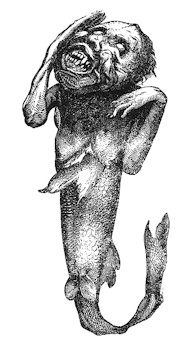
The Feejee Mermaid in all
its hideous glory - in 1842.
|
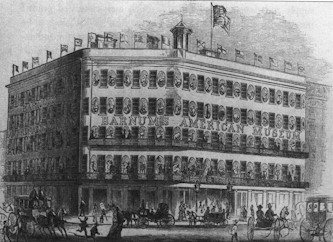
P.T. Barnum's "Museum" in New York City.
|
|
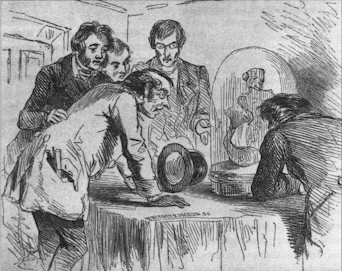
Viewers trying to make sense of Barnum's "Mermaid."
|
|
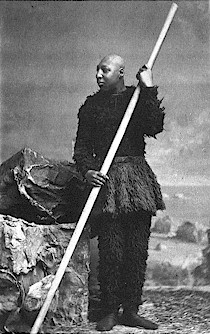
Matthew Brady's photograph of
"What Is It?" in 1860.
|
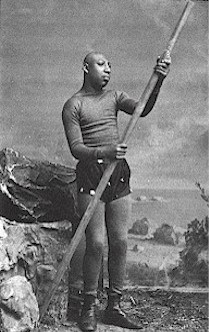
Barnum used a fur suit, shaved
head and exotic backgrounds to
reinforce his racist hoax.
|
Barnum hinted that "What Is It?" was a "missing link" between man and animals. Barnum said, "We know not and therefore do not assert whether it is human or animal. We leave that all to the sagacious public to decide" (Cook, ibid., p. 134).
Dr. James W. Cook says,
Numerous publicity photographs suggest that ["What Is It?"] was a short, African-American man with a sharply sloping brow line, although as one writer observed…out of costume - and removed from the circus platform - there was nothing particularly exceptional about his famous head, [he] may have suffered from microcephaly, a physiological condition that produces mental retardation (Cook, ibid., p. 129).
Conclusion
It was into this social situation that Charles Darwin's books on evolution were published. It was a time of apostasy - so the churches could not answer Darwin's ideas adequately. It was a time of scientific invention, which gave credibility to Darwin's books. It was a time of great progress in many fields - so it appeared that man might indeed be "evolving" into a higher form. It was a time of colonizing, which brought many curiosities from Africa and the Orient to the English-speaking world, and great multitudes of people were interested in seeing and hearing about those curiosities. All of this made Darwin's books on evolution extremely popular. They sold out, in edition after edition. The idea of the evolution of man from lower life forms literally exploded into the common culture and thought of the average person in the English-speaking world.
But was Darwin right? Did human beings, apes, and monkeys evolve from lower life forms? The evolutionists have had close to 150 years to prove their theory - and they have not done so. I say that evolution is nothing but a cheap hoax - that belongs in P. T. Barnum's circus - not in a high school or college classroom!
Sir John William Dawson pioneered Canadian geology and served as president of both McGill University and the British Association for the Advancement of Science. Dawson said:
Let the reader take up either of Darwin's…books or Spencer's "Biology," and merely ask himself as he reads each paragraph, "What is assumed here and what is proved?" And he will find the whole fabric melt away like a vision…We thus see that evolution as an hypothesis has no basis in experience or scientific fact, and that its imagined series of transmutations [evolution] has breaks which cannot be filled (Sir William Dawson, The Story of Earth and Man, New York: Harper and Brothers, 1887, pp. 330, 339).
Dr. Wolfgang Smith taught at MIT and UCLA, and has written on a broad spectrum of scientific topics. Dr. Smith said:
The fact remains that there exists to this day not a shred of bona fide evidence in support of the thesis that macroevolutionary transformations ever occurred (Wolfgang Smith, Ph.D., Teilhardism and the New Religion, Rockford, Illinois: Tan Books, 1988, pp. 5-6).
And yet your college textbooks still teach the outworn, Victorian hoax - the greatest fraud of all time. Why do people still believe Darwin's evolution? A big part of the reason is because P. T. Barnum was right. This great showman and master hoaxster said, "There's a sucker born every minute." And the Bible predicted it:
"…they shall turn away their ears from the truth, and shall be turned unto fables" (II Timothy 4:4).
Young person, evolution has given you nothing but a burned out "brave new world!" Evolution took away the old world of faith, church attendance, large families and many friends. In the place of those happy things, evolution has given you the "brave new world" of loneliness, no church, no faith in Christ, no hope for the future. I say, "Away with evolution!" Let's go back to the Bible! Let's go back to church every Sunday! Let's go to Christ and have our sins washed clean by His precious Blood!
Make sure you come back to this gospel preaching church. Make sure you come to the risen Christ. Make sure He has washed away all your sins! Why be lonely? Come home - to church! Why be lost in a life of sin? Come home - to Christ!
We're going to stand and sing "Give Me That Old-Time Religion." While we sing, I want you to leave your seat and come and stand here in front of this pulpit. After you have all come to stand here, we will go to my office and I will tell you more about how you can know Christ and have your sins washed away by His Blood. While we sing, you come!
(END OF SERMON)
Scripture Read Before the Sermon by Dr. Kreighton L. Chan: II Timothy 4:1-5.
Solo Sung Before the Sermon by Mr. Benjamin Kincaid Griffith:
"This Is My Father's World" (by Maltbie D. Babcock, 1858-1901)/
"Give Me That Old-Time Religion."
|
THE OUTLINE OF
P. T. BARNUM, THE FEEJEE MERMAID
AND THE MISSING LINK!
(WITH PHOTOGRAPHS)
by Dr. R. L. Hymers, Jr.
|
|
"And they shall turn away their ears from the truth, and shall be turned unto fables" (II Timothy 4:4).
I. The late nineteenth century was a time of apostasy.
II. The late nineteenth century was a time of many
scientific inventions.
III. The late nineteenth century was a time of colonizing.
IV. The late nineteenth century was a time of common
interest in curiosities.
|
You can read Dr. Hymers' sermons each week on the Internet
at www.realconversion.com. Click on "Sermon Manuscripts."




